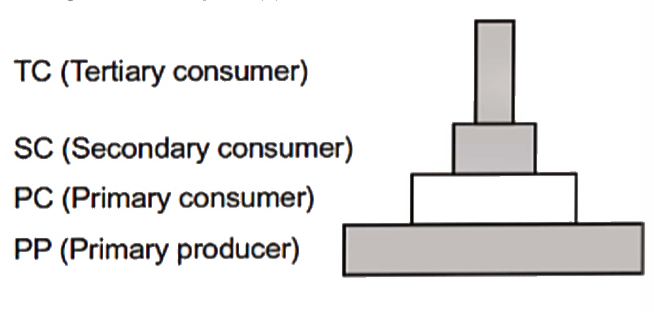What type of ecological pyramid would be obtained with the following data ?
Secondary consumer : 120 g
Primary consumer : 60 g
Primary producer : 10 g
Pyramid of energy
Upright pyramid of numbers
Inverted pyramid of biomass
Upright pyramid of biomass
To determine the type of ecological pyramid based on the given data, we will analyze the biomass at each trophic level. The data provided is as follows:
- Secondary consumer: 120 g
- Primary consumer: 60 g
- Primary producer: 10 g
1. Identify the Trophic Levels:
- The primary producers are at the base of the pyramid (10 g).
- The primary consumers (herbivores) are the next level (60 g).
- The secondary consumers (carnivores) are at the top (120 g).
2. Analyze the Biomass:
- The biomass of the primary producers is 10 g.
- The biomass of the primary consumers is 60 g.
- The biomass of the secondary consumers is 120 g.
3. Determine the Shape of the Pyramid:
- In a typical ecological pyramid, the biomass generally decreases as you move up the trophic levels (from producers to consumers).
- Here, the biomass increases as we move from primary producers (10 g) to primary consumers (60 g) to secondary consumers (120 g).
4. Conclusion:
- Since the biomass increases as we move up the trophic levels, this represents an inverted pyramid of biomass. In an inverted pyramid, the biomass of higher trophic levels exceeds that of lower trophic levels.
Final Answer:
The type of ecological pyramid obtained with the given data is an inverted pyramid of biomass.
- Primary consumer: 60 g
- Primary producer: 10 g
- The primary producers are at the base of the pyramid (10 g).
- The primary consumers (herbivores) are the next level (60 g).
- The secondary consumers (carnivores) are at the top (120 g).
- The biomass of the primary producers is 10 g.
- The biomass of the primary consumers is 60 g.
- The biomass of the secondary consumers is 120 g.
- In a typical ecological pyramid, the biomass generally decreases as you move up the trophic levels (from producers to consumers).
- Here, the biomass increases as we move from primary producers (10 g) to primary consumers (60 g) to secondary consumers (120 g).
- Since the biomass increases as we move up the trophic levels, this represents an inverted pyramid of biomass. In an inverted pyramid, the biomass of higher trophic levels exceeds that of lower trophic levels.
The type of ecological pyramid obtained with the given data is an inverted pyramid of biomass.
Topper's Solved these Questions
- ECOSYSTEMBOOK - VMC MODULES ENGLISHCHAPTER - ECOSYSTEMEXERCISE - EFFICIENT
49 Videos
- BIOTECHNOLOGY AND ITS APPLICATIONS BOOK - VMC MODULES ENGLISHCHAPTER - BIOTECHNOLOGY AND ITS APPLICATIONS EXERCISE - IMPECCABLE
51 Videos
- EVOLUTION BOOK - VMC MODULES ENGLISHCHAPTER - EVOLUTION EXERCISE - IMPECCABLE
54 Videos
Similar Questions
Knowledge Check
What mass of sodium chloride would be decomposed by 9.8 g of sulphuric acid if 12 g of sodium bisulphate and 2.75 g of hydrogen chloride were produced in a reaction?
A14.75 gB3.8 gC4.95 gD2.2 g
Which of the following acts as a primary as well a secondary consumer in the forest eco-system?
View SolutionWrite each of the following sets in Roster form and write the cardinal number of each .
G = {x: x is a primary colour }
View SolutionIn most ecosystems , the pyramid of ___________ is always upright when there are more producers than primary consumers .
View SolutionDenny ate spinach, salad and mutton curry for lunch. At which of the following trophic levels did Danny function in this food chain?
(i) Producer
(ii) Primary consumer
(iii) Secondary consumer
(iv) Tertiary consumer
View SolutionCalculate the mass of magnesium oxide which would be obtained by burning 120 g of magnesium in air.
View SolutionName the dominant producers in a deep aquatic system. What other name could you give to a primary consumer?
View SolutionCalculate the heat of fusion of ice from the following data of ice at 0∘C added to water. Mass of calorimeter=60g, mass of calorimeter+ water =460g,
mass of calorimeter+water+ice=618g, initial temperature of water =38∘C, final temperature of the mixture=5∘C. The specific heat of calorimeter =0.10cal/g/∘C. Assume that the calorimeter was also at 0∘C initially
View Solution

